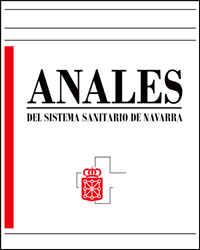Inguinal tumor: a rare occurrence of hydatid disease. A case report
Keywords:
Tumoración inguinal, Hidatidosis ósea, Equinococcus granulosusAbstract
Osseous hydatid disease is an infrequent entity that represents 0.5-2.5% of all hydatidoses. The vertebrae are the most commonly affected bones (50%), followed by the pelvis (25%) and the long bones (15-25%). The clinical manifestations appear when there is large scale osseous destruction or complications, which is why the diagnosis is generally made in late stages through imaging techniques and on occasion in an intra-operational form. Treatment in operable cases is by surgical extirpation, which can be associated with medical treatment with albendazol. We present the case of a patient with osseous hydatidosis, localised in the pelvis, with an absence of other affected organs. The only clinical manifestation presented by the patient was an inguinal tumour on the right side. The patient received a clinical intervention facing the suspicion of an inguinal hernia, complicated by the intra-operational discovery of pelvic hydatidosis.Downloads
Downloads
Published
How to Cite
Issue
Section
License
La revista Anales del Sistema Sanitario de Navarra es publicada por el Departamento de Salud del Gobierno de Navarra (España), quien conserva los derechos patrimoniales (copyright ) sobre el artículo publicado y favorece y permite la difusión del mismo bajo licencia Creative Commons Reconocimiento-CompartirIgual 4.0 Internacional (CC BY-SA 4.0). Esta licencia permite copiar, usar, difundir, transmitir y exponer públicamente el artículo, siempre que siempre que se cite la autoría y la publicación inicial en Anales del Sistema Sanitario de Navarra, y se distinga la existencia de esta licencia de uso.








